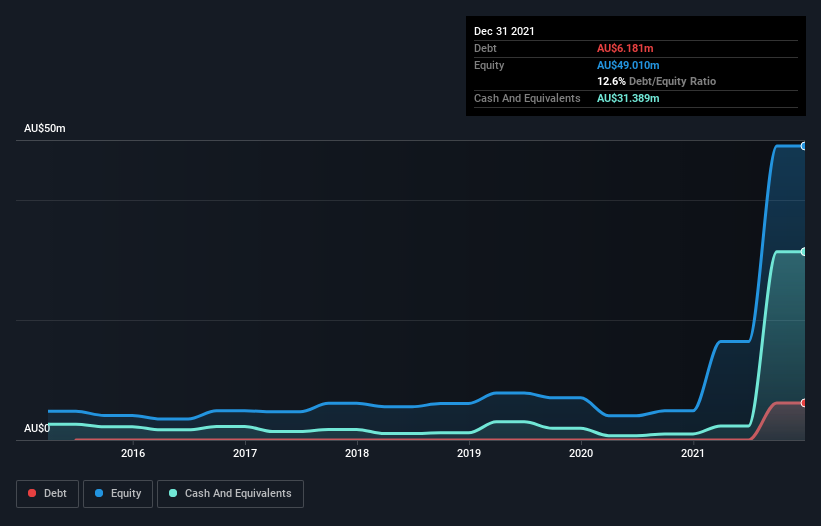Health Check: How Prudently Does Hawsons Iron (ASX:HIO) Use Debt?
David Iben put it well when he said, 'Volatility is not a risk we care about. What we care about is avoiding the permanent loss of capital.' It's only natural to consider a company's balance sheet when you examine how risky it is, since debt is often involved when a business collapses. We note that Hawsons Iron Limited (ASX:HIO) does have debt on its balance sheet. But should shareholders be worried about its use of debt?
What Risk Does Debt Bring?
Debt and other liabilities become risky for a business when it cannot easily fulfill those obligations, either with free cash flow or by raising capital at an attractive price. Part and parcel of capitalism is the process of 'creative destruction' where failed businesses are mercilessly liquidated by their bankers. However, a more usual (but still expensive) situation is where a company must dilute shareholders at a cheap share price simply to get debt under control. Of course, the upside of debt is that it often represents cheap capital, especially when it replaces dilution in a company with the ability to reinvest at high rates of return. When we think about a company's use of debt, we first look at cash and debt together.
View our latest analysis for Hawsons Iron
What Is Hawsons Iron's Net Debt?
You can click the graphic below for the historical numbers, but it shows that as of December 2021 Hawsons Iron had AU$6.18m of debt, an increase on none, over one year. But on the other hand it also has AU$31.4m in cash, leading to a AU$25.2m net cash position.
How Healthy Is Hawsons Iron's Balance Sheet?
The latest balance sheet data shows that Hawsons Iron had liabilities of AU$5.06m due within a year, and liabilities of AU$6.44m falling due after that. On the other hand, it had cash of AU$31.4m and AU$774.2k worth of receivables due within a year. So it can boast AU$20.7m more liquid assets than total liabilities.
This excess liquidity suggests that Hawsons Iron is taking a careful approach to debt. Due to its strong net asset position, it is not likely to face issues with its lenders. Succinctly put, Hawsons Iron boasts net cash, so it's fair to say it does not have a heavy debt load! When analysing debt levels, the balance sheet is the obvious place to start. But you can't view debt in total isolation; since Hawsons Iron will need earnings to service that debt. So if you're keen to discover more about its earnings, it might be worth checking out this graph of its long term earnings trend.
Given its lack of meaningful operating revenue, investors are probably hoping that Hawsons Iron finds some valuable resources, before it runs out of money.
So How Risky Is Hawsons Iron?
By their very nature companies that are losing money are more risky than those with a long history of profitability. And in the last year Hawsons Iron had an earnings before interest and tax (EBIT) loss, truth be told. Indeed, in that time it burnt through AU$5.7m of cash and made a loss of AU$3.8m. Given it only has net cash of AU$25.2m, the company may need to raise more capital if it doesn't reach break-even soon. Overall, its balance sheet doesn't seem overly risky, at the moment, but we're always cautious until we see the positive free cash flow. The balance sheet is clearly the area to focus on when you are analysing debt. However, not all investment risk resides within the balance sheet - far from it. For example, we've discovered 5 warning signs for Hawsons Iron (3 are a bit concerning!) that you should be aware of before investing here.
At the end of the day, it's often better to focus on companies that are free from net debt. You can access our special list of such companies (all with a track record of profit growth). It's free.
Have feedback on this article? Concerned about the content? Get in touch with us directly. Alternatively, email editorial-team (at) simplywallst.com.
This article by Simply Wall St is general in nature. We provide commentary based on historical data and analyst forecasts only using an unbiased methodology and our articles are not intended to be financial advice. It does not constitute a recommendation to buy or sell any stock, and does not take account of your objectives, or your financial situation. We aim to bring you long-term focused analysis driven by fundamental data. Note that our analysis may not factor in the latest price-sensitive company announcements or qualitative material. Simply Wall St has no position in any stocks mentioned.

 Yahoo Finance
Yahoo Finance 
